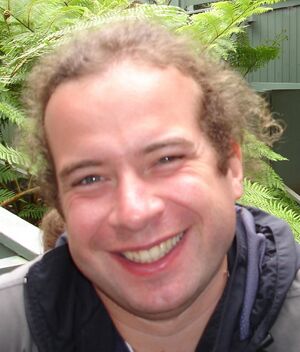User:Jacques Pecreaux
Contact Info

- Dr Jacques Pecreaux
- Dr Jacques Pecreaux
Education
- 2004, PhD in physics, University Pierre et Marie Curie (Paris 6), France
- 1999, PostGraduate Certificate in liquids physics, University Pierre et Marie Curie (Paris 6), France
- 1998, Engineer diploma, Ecole Polytechnique, Palaiseau, France
Achievements
After an education in Physics at Ecole Polytechnique, I oriented my work toward biological physics, first using methods of physics on DNA. Then during my PhD at Curie Institute on model system, I studied the undulations of a lipidic membrane mimicking cell cytoplasmic membrane. Combining biophysical modeling and advanced image processing, I succeeded in measuring directly, optically, and in a model independent way, the distribution of wavelengths of these undulations: the fluctuation spectrum. I then turned to experiments on an in vivo system: the one cell embryo of nematode Caenorhabditis elegans. As a postdoctoral fellow supervised by Pr Jonathon Howard and Pr Anthony A. Hyman, I developed the first steps of a systems biophysical modeling of cell division based on in vivo experiments, and supported by self developed image processing tools. We could account for anaphase spindle rocking, posterior displacement, and the role of the cortex e.g. During a second postdoctoral training, supervised by Dr Andrew Oates, I designed a non supervised image processing detection of segmentation defects in zebrafish embryos using brightfield images, to enable a biophysics modeling of the phenomenon. This was the opportunity to improve my knowledge in developmental biology, in particular cell-cell signaling, and to get proficient in developing image processing based on java and ImageJ. In June 2010, I obtained a grant (ATIP, CNRS) to start a group in IGDR, In Rennes, France where I will move in January 2011.
Research interests
Cell division’s complex choreography is driven by the interactions of cytoskeletal motors and filaments. I asserts that physics is essential to understand not only the molecular players’ details, but also their signaling and regulation. Asymmetric division, where daughter cell size and contents differ, is dynamic, thus facilitating reverse engineering of mechanisms. Until now, molecular biology and in vitro biophysics have characterized the players, while simulations only accounted for cell-level phenotypes. I envision an experimental systems biophysics strategy, quantitatively linking these micro- and macroscopic approaches. This will be relevant to basic and applied cell division, and microfilaments research, particularly infection. Starting with the nematode embryo familiar to me, I will pursue fruit-fly. Using my multidisciplinary training, I lead a team performing systems biophysics modeling to account for collective behaviors, validation by in vivo experiments, and quantification by advanced image processing.
Publications
-
Redemann, S.*, Pecreaux, J.*, Goehring, N.W., Khairy, K., Stelzer, E.H., Hyman, A.A., and Howard, J. (2010). Membrane invaginations reveal cortical sites that pull on mitotic spindles in one-cell C. elegans embryos. PLoS One 5. Pubmed HubMed Download pdf
-
El Alaoui Faris, M.D., Lacoste, D., Pecreaux, J., Joanny, J.F., Prost, J., and Bassereau, P. (2009). Membrane tension lowering induced by protein activity. Phys Rev Lett 102, 038102.Pubmed HubMed Download pdf
-
Zimyanin, V.L., Belaya, K., Pecreaux, J., Gilchrist, M.J., Clark, A., Davis, I., and St Johnston, D. (2008). In vivo imaging of oskar mRNA transport reveals the mechanism of posterior localization. Cell 134, 843-853. Pubmed HubMed Download pdf
 (read the reviews)
(read the reviews) -
Khairy, K.*, Pecreaux, J.*, and Howard, J. (2007). Spherical Harmonics 3D Active Contours for Membrane Bilayer-Bound Surfaces. In 10th International Conference on Medical Image Computing and Computer-Assisted Intervention (MICCAI), Workshop : Computational biomechanics for medicine II, K. Miller, K.D. Paulsen, A.A. Young, and P.M.F. Nielsen, eds. (October 29-November 2, Brisbane, Australia). Download pdf
-
Pecreaux, J., Zimmer, C., and Olivo-Marin, J.C. (2006). Biophysical active contours for cell tracking I: Tension and bending. Paper presented at: 2006 IEEE International Conference on Image Processing, Icip 2006, Proceedings (October 8-11 2006, Atlanta, GA, USA). Download pdf
-
Solon, J., Pecreaux, J., Girard, P., Faure, M.C., Prost, J., and Bassereau, P. (2006). Negative tension induced by lipid uptake. Phys Rev Lett 97, 098103. Pubmed HubMed Download pdf
-
Pecreaux, J.*, Roper, J.C.*, Kruse, K., Julicher, F., Hyman, A.A., Grill, S.W., and Howard, J. (2006). Spindle oscillations during asymmetric cell division require a threshold number of active cortical force generators. Curr Biol 16, 2111-2122. Pubmed HubMed Download pdf
 (read the reviews)
(read the reviews) -
Girard, P.*, Pecreaux, J.*, Lenoir, G., Falson, P., Rigaud, J.L., and Bassereau, P. (2004). A new method for the reconstitution of membrane proteins into giant unilamellar vesicles. Biophys J 87, 419-429. Pubmed HubMed Download pdf
-
Pécréaux, J., Döbereiner, H.-G., Prost, J., Joanny, J.-F., and Bassereau, P. (2004). Refined contour analysis of giant unilamellar vesicles. European Physical Journal E 13, 277-290. Pubmed HubMed Download pdf